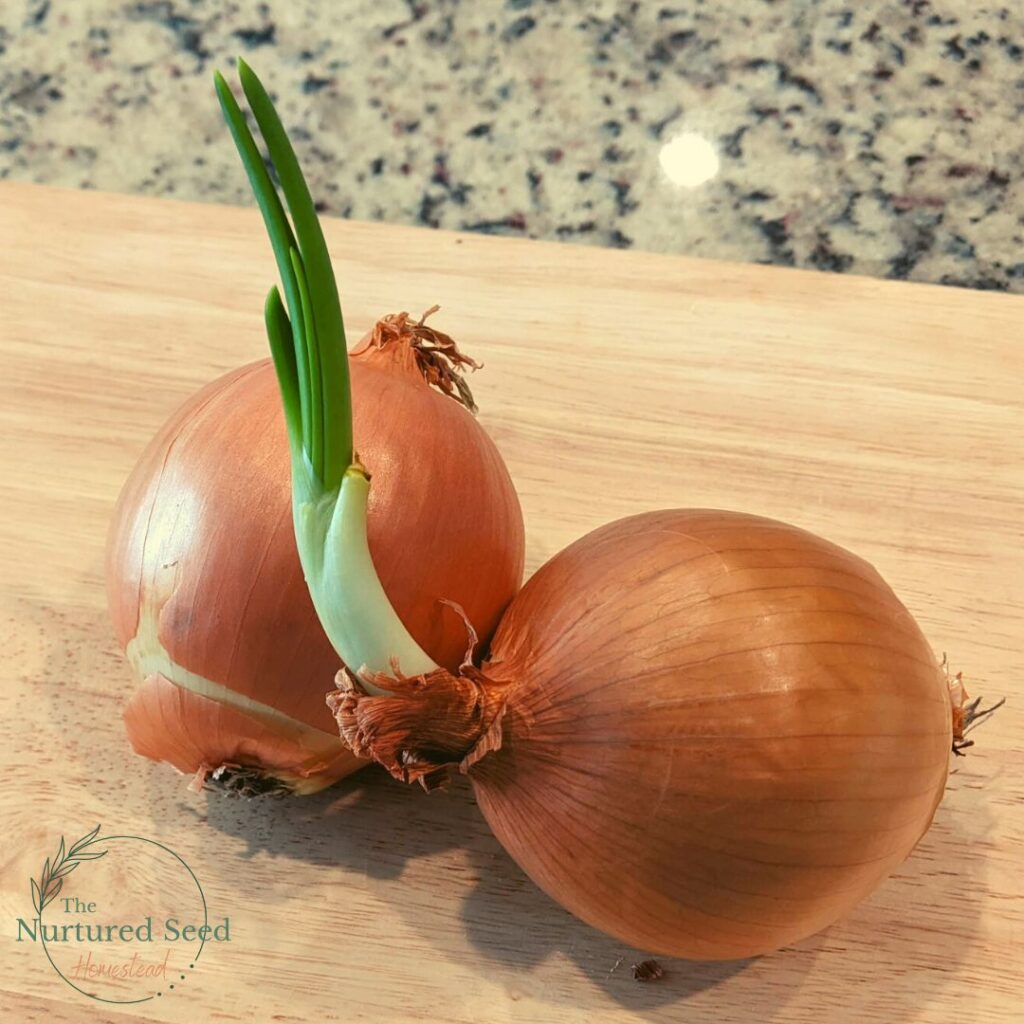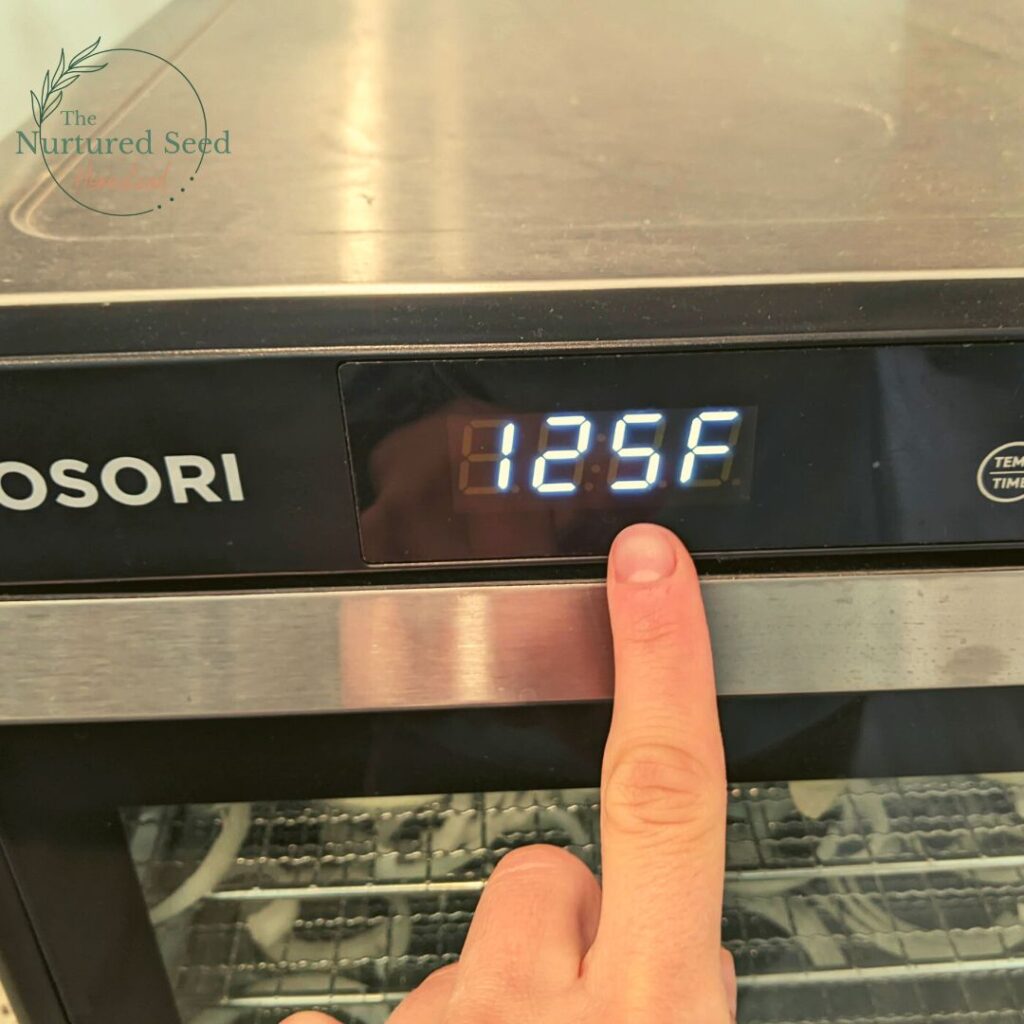How to Dehydrate Onions: Make Onion Powder
Step by step directions on how to dehydrate onions and make onion powder yourself! A perfect way to preserve your homegrown onions.

Dehydrating food is a great way to extend the life of your produce and increase your food storage. The nutritional value of dehydrated food is better than if canned or preserved by freezing.
Lucky for you, I am going to share my easy steps to dehydrate your very own onions.
Tips for dehydrating onions
- Use a food dehydrator (I use a Cosori Dehydrator and like it)
- Dehydrate onions in a well-ventilated area. The smell of onions is VERY strong when they are being dehydrated (ask how I know…). I would suggest to dehydrate onions outside or in your garage if you can.
- Slice the onions as evenly as you can before putting them on dehydrating trays.
- If you are sensitive to onions you can wear goggles and gloves while slicing the onions.
- Use a food processor to chop your onions. Just pulse a few times. This would make the process of chopping the onions happen quicker, but you may not get even pieces.
- Save peels and trimmed off pieces for making bone broth later. I just stick mine in a freezer bag for the next time I am making bone broth. They can also be composted.
Why do you dehydrate onions?

The number one reason is to save any onions that I have from going bad. There is a certain time of year when my homegrown onions start reaching the end of their time.
I like to save all that hard work by turning them into dehydrated onions. I am very relieved when I don’t have to throw out my onions!
Another reason is that it is simply nice to have onion powder, dry onion flakes, or dry minced onions on hand. Some days I need to get dinner whipped up real quick and using dehydrated onions saves me a few minutes.
What onions can be dehydrated?
There are many different types of onions out there. Any of the varieties that you choose can become dried onions. Some may have a longer shelf life than others.
- red onions
- white onions
- green onions
- yellow onions
- sweet onions
- vidalia onions
How do I use my dehydrated onions?

When using your dehydrated onions in soups, stews or whenever there is liquid in the meal, you don’t really need to do anything besides simply add them to your food. The liquid in the meal will hydrate the onions adding flavor.
A lot of times you will get a recipe that calls for onion powder instead of a fresh chopped onion anyway. When you are dehydrating onions, think about what ways you are most likely going to use you onion.
For things like stews a roughly chopped onion is nice to have. When you have a recipe where you don’t really want the actual texture of an onion then powder form is great.
I like using minced onions in my tacos but could use onion powder as well. Because I find the onion powder to be more versatile, that is what I usually end up making.
If you are wanting to make your own salad dressings, I would suggest onion powder.
Dehydrated onion powder conversions

Prepare to dehydrate onions
Onions are more simple than some veggies when it comes to preparing them to be dehydrated. The process is simple, but the powerful aroma makes it a little more uncomfortable.
If you are sensitive to this, you can wear goggles and/or gloves to help with this. I’m usually too lazy for things like that and just grit my way through.
Using a sharp knife cut off ends and peel off the skins. Save these in your freezer for making bone broth. Then slice your raw onions into thin slices, smaller pieces or onion rings.

How to dehydrate onions
Here are your step by step directions for dehydrating onions. I am using a Cosori food dehydrator for this process, but any food dehydrator will do the job and really is the easiest way to dehydrate onions.
- Spread out your sliced onions or small pieces onto your dehydrator trays. Make sure they are in a single layer.
- Use parchment paper on trays if your onion pieces are falling through. My dehydrator comes with a tray that holds smaller pieces, but parchment paper works too!
- Slide your trays into your dehydrator and set the drying time to 125 DEGREES F for 3-12 hours. The time varies depending on how thick your onion slices are. Start it out at three hours and check the onions. If they are brittle, then they are ready. If not, then you simply add time to your dehydrator.

4. Once the onions are crisp, then let them cool for at least 30 minutes. You do NOT want to put warm dehydrated onions into a jar because they will get soft.
5. After the onions are cooled either turn them into onion powder (see below) or put them into airtight glass jars for conditioning.
Condition your dehydrated onions
Condition is the process of checking your dehydrated foods for excess moisture. The process lasts 7-10 days. During this process you check your dry onions by shaking the jar around and checking for any drops of moisture.
If you notice any moisture, then simple put the onions back into your dehydrator and dry them again. After you have conditioned your onions, then you can store them for 1-2 years depending on how you have stored them.
How to store your dehydrated onions

When you have dehydrated onions, you need to store them in a dark place out of direct sunlight. They should always be stored in airtight mason jars or storage containers.
If you want your onions to last a long time, then add oxygen absorbers to your jar. It is a good idea to store your dehydrated onions in a cool dry location as best as you can.
How to rehydrate dehydrated onions
The best way to do this is simply add your dehydrated onions to a bowl of warm water and wait a few minutes for them to rehydrate.
I would do this with sliced or diced onions to use in recipes, but not with onion powder.
If you check your bowl and see that it has run out of water and the onions aren’t done rehydrating, then add more warm water. When they are hydrated, strain off the excess water
How to make onion powder

It is really easy to make onion powder. Simply take your dried onion pieces and grind them up. You can use a blender, food process or even a coffee grinder. You will still want to go through with he same conditioning and storing procedures.
Let me know your favorite way to use your dehydrated onions!

